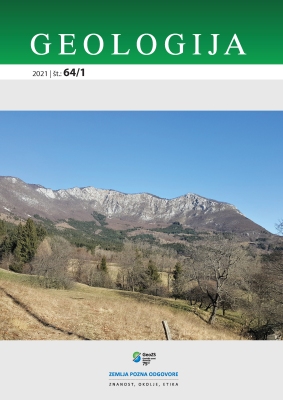Model nastanka suhe doline Pradol (zahodna Slovenija, severovzhodna Italija)
DOI:
https://doi.org/10.5474/geologija.2021.002Povzetek
V tektonsko aktivnih gorovjih površje oblikujejo interakcije med erozijo, sedimentacijo in tektonsko gnanimi deformacijami skorje. Časovni razvoj oblikovanosti površja lahko rekonstruiramo s študijem značilnih površinskih oblik kot so morene, suhe doline, prelomni robovi in rečne terase, vendar pa so razpoložljivi podatki pogosto dvoumni in dopuščajo različne interpretacije. V prispevku obravnavamo globoko vrezano sotesko Pradol (Pradolina) v zahodni Sloveniji, katere dno leži nekaj sto metrov nad okoliškimi dolinami. Da bi ugotovili nastanek te nenavade geomorfne oblike smo uporabili visokoločljive digitalne modele višin, geomorfne indekse in terenska opazovanja. V prispevku predstavljamo šestfazni razvoj soteske, ki vključuje zajezitev doline z napredujočim ledenikom, preusmeritev reke in njeno hitro vrezovanje zaradi velike količine vode ob postglacialnem taljenju ledu. Nastanek Pradola je bil najverjetneje pogojen s prisotnostjo preloma, katerega prelomna cona je predstavljala lahko erodibilno cono šibkosti v mezozojskih apnencih. Naš model kaže, da bi soteska lahko v celoti nastala v zadnji poledenitvi, kar bi pomenilo hitrosti vrezovanja do nekaj cm na leto. Predlagani model pojasni vsa dostopna daljinska in terenska opažanja. Študija nakazuje, da je nastanek Pradola posledica kompleksnih interakcij različnih geomorfnih procesov, ter da je v obdobju od zadnje poledenitve prišlo do hitrih sprememb v morfologiji površja.Prenosi
Kako citirati
Diercks, M., Grützner, C., Vrabec, M., & Ustaszewski, K. (2021). Model nastanka suhe doline Pradol (zahodna Slovenija, severovzhodna Italija). Geologija, 64(1), 21–33. https://doi.org/10.5474/geologija.2021.002
Številka
Rubrika
Članki

